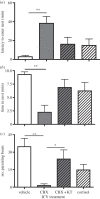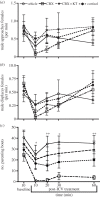A mechanism for rapid neurosteroidal regulation of parenting behaviour
- PMID: 24827441
- PMCID: PMC4046405
- DOI: 10.1098/rspb.2014.0239
A mechanism for rapid neurosteroidal regulation of parenting behaviour
Abstract
While systemic steroid hormones are known to regulate reproductive behaviour, the actual mechanisms of steroidal regulation remain largely unknown. Steroidogenic enzyme activity can rapidly modulate social behaviour by influencing neurosteroid production. In fish, the enzyme 11β-hydroxysteroid dehydrogenase (11β-HSD) synthesizes 11-ketotestosterone (KT, a potent teleost androgen) and deactivates cortisol (the primary teleost glucocorticoid), and both of these steroid hormones can regulate behaviour. Here, we investigated the role of neurosteroidogenesis in regulating parenting in a haremic bidirectionally hermaphroditic fish, Lythrypnus dalli, where males provide all requisite parental care. Using an in vitro assay, we found that an 11β-HSD inhibitor, carbenoxolone (CBX), reduced brain and testicular KT synthesis by 90% or more. We modulated neurosteroid levels in parenting males via intracerebroventricular injection of CBX. Within only 20 min, CBX transiently eliminated parenting behaviour, but not other social behaviour, suggesting an enzymatic mechanism for rapid neurosteroidal regulation of parenting. Consistent with our proposed mechanism, elevating KT levels rescued parenting when paired with CBX, while cortisol alone did not affect parenting. Females paired with the experimental males opportunistically consumed unattended eggs, which reduced male reproductive success by 15%, but some females also exhibited parenting behaviour and these females had elevated brain KT. Brain KT levels appear to regulate the expression of parenting behaviour as a result of changes in neural 11β-HSD activity.
Keywords: androgen; cortisol; fish; fitness; glucocorticoid; reproduction.
© 2014 The Author(s) Published by the Royal Society. All rights reserved.
Figures





Similar articles
-
Elevated 11-ketotestosterone during paternal behavior in the Bluebanded goby (Lythrypnus dalli).Horm Behav. 2006 May;49(5):610-4. doi: 10.1016/j.yhbeh.2006.01.008. Epub 2006 Mar 9. Horm Behav. 2006. PMID: 16524575
-
Local modulation by 11beta-hydroxysteroid dehydrogenase of glucocorticoid effects on the activity of 15-hydroxyprostaglandin dehydrogenase in human chorion and placental trophoblast cells.J Clin Endocrinol Metab. 1999 Feb;84(2):395-400. doi: 10.1210/jcem.84.2.5442. J Clin Endocrinol Metab. 1999. PMID: 10022390
-
Contextual modulation of androgen effects on agonistic interactions.Horm Behav. 2014 Jan;65(1):47-56. doi: 10.1016/j.yhbeh.2013.11.006. Epub 2013 Dec 5. Horm Behav. 2014. PMID: 24315925
-
It takes two! Exploring sex differences in parenting neurobiology and behaviour.J Neuroendocrinol. 2019 Sep;31(9):e12721. doi: 10.1111/jne.12721. Epub 2019 May 26. J Neuroendocrinol. 2019. PMID: 31034670 Free PMC article. Review.
-
Environmental stress-induced testis differentiation: androgen as a by-product of cortisol inactivation.Gen Comp Endocrinol. 2013 Oct 1;192:36-44. doi: 10.1016/j.ygcen.2013.05.024. Epub 2013 Jun 11. Gen Comp Endocrinol. 2013. PMID: 23770022 Review.
Cited by
-
Sex differences in neuromuscular androgen receptor expression and sociosexual behavior in a sex changing fish.PLoS One. 2017 May 16;12(5):e0177711. doi: 10.1371/journal.pone.0177711. eCollection 2017. PLoS One. 2017. PMID: 28520775 Free PMC article.
-
Changes in behavior and brain immediate early gene expression in male threespined sticklebacks as they become fathers.Horm Behav. 2018 Jan;97:102-111. doi: 10.1016/j.yhbeh.2017.11.002. Epub 2017 Nov 14. Horm Behav. 2018. PMID: 29117505 Free PMC article.
-
Do reproduction and parenting influence personality traits? Insights from threespine stickleback.Anim Behav. 2016 Feb 1;112:247-254. doi: 10.1016/j.anbehav.2015.12.002. Anim Behav. 2016. PMID: 26955065 Free PMC article.
-
Neuroendocrine disruption of organizational and activational hormone programming in poikilothermic vertebrates.J Toxicol Environ Health B Crit Rev. 2017;20(5):276-304. doi: 10.1080/10937404.2017.1370083. J Toxicol Environ Health B Crit Rev. 2017. PMID: 28895797 Free PMC article. Review.
-
Sex diversity in the 21st century: Concepts, frameworks, and approaches for the future of neuroendocrinology.Horm Behav. 2024 Jan;157:105445. doi: 10.1016/j.yhbeh.2023.105445. Epub 2023 Nov 17. Horm Behav. 2024. PMID: 37979209 Free PMC article.
References
-
- Borg B. 1994. Androgens in teleost fishes. Comp. Biochem. Physiol. C 109C, 219–245. (10.1016/0742-8413(94)00063-G) - DOI
-
- Wingfield JC, Hegner RE, Dufty AM, Jr, Ball GF. 1990. The ‘challenge hypothesis’: theoretical implications for patterns of testosterone secretion. Am. Nat. 136, 829–846. (10.1086/285134) - DOI
Publication types
MeSH terms
Substances
LinkOut - more resources
Full Text Sources
Other Literature Sources

